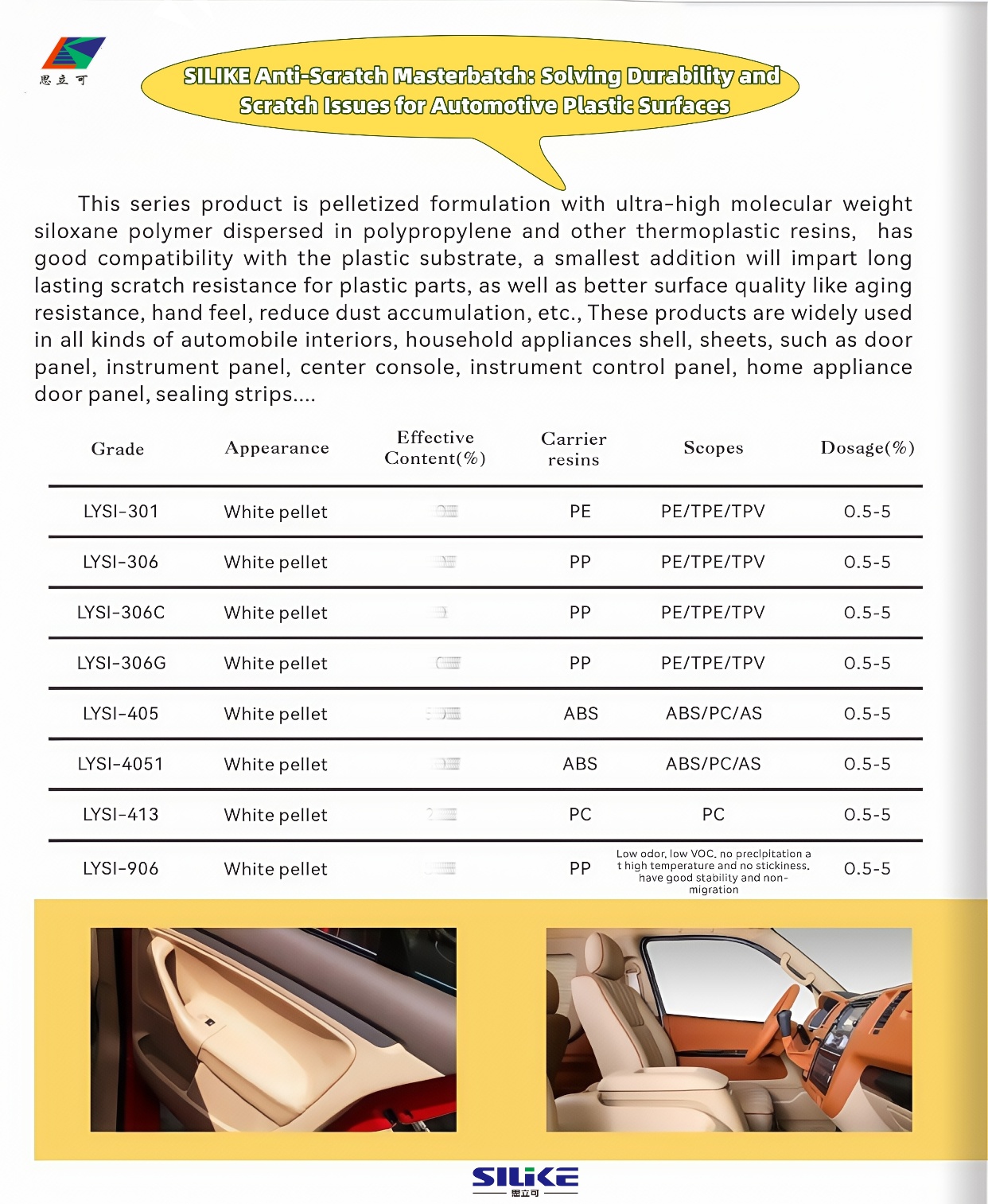In the automotive industry, the durability, aesthetic appeal, and human health of interior plastic components are top priorities.
Polypropylene (PP) has become one of the most widely used materials in automotive interiors, thanks to its lightweight properties, cost-effectiveness, and versatility. However, its susceptibility to scratching and abrasion remains a major pain point—especially in high-traffic areas like dashboards, door panels, and center consoles. To address this issue, anti-scratch additives are added to polypropylene during manufacturing. But with so many options on the market, how do you choose the best anti-scratch additive? Which anti-scratch additive is the best choice for automotive interiors? Let’s explore the key considerations and top contenders.
Top Anti-Scratch Additives for Polypropylene
Several types of anti-scratch additives are available, each with its unique advantages. Here are the most commonly used options:
1. SILIKE Silicone Masterbatch Anti-Scratch Series
SILIKE’s Anti-Scratch Masterbatch Series is a pelletized formulation with ultra-high molecular weight siloxane polymers dispersed in polypropylene and other thermoplastic resins. This scratch resistance additive offers excellent compatibility with the plastic substrate. These mar resistance modifiers enhance compatibility with the Polypropylene (CO-PP/HO-PP) matrix, resulting in lower phase segregation on the final surface. This means it stays on the surface of the final plastics without any migration or exudation, reducing fogging, VOCs, or odors.
A small addition imparts long-lasting scratch resistance to plastic parts, as well as better surface quality, including aging resistance, hand feel, and reduced dust accumulation. These scratch-resistant agents products are widely used in PP, TPO, TPE, TPV, PC, ABS, and PC/ABS modified materials, in automotive interiors, household appliance shells, and sheets, such as door panels, dashboards, center consoles, instrument panels, home appliance door panels, and sealing strips.
Benefits: Provides superior scratch resistance for PP and TPO auto-body parts. The pelletized formulation with ultra-high molecular weight siloxane polymer ensures good compatibility and low VOCs.
Use Case: Ideal for automotive interior applications, such as improving the anti-scratch properties of TPE, TPV, PP, and PP/PPO talc-filling systems.
In SILIKE’s lab tests, by adding 1.5-3% anti-scratch silicone masterbatch LYSI-306C to the PP/TPO system, the scratch resistance test can pass and meet VW’s PV3952 and GM’s GMW14688 standards. Under a pressure of 10 N, the ΔL can achieve <1.5, with no stickiness and low VOCs.
2. DuPont MULTIBASE™ HMB-0221, MB50-001, and MB50-0221/G2
Benefits: These additives demonstrate high scratch resistance, meeting the VW PV3952 standard. They contain ultra-high molecular weight siloxane polymers and improve UV resistance without exudation.
Use Case: Suitable for fine-grained PP copolymer with talc, offering enhanced scratch resistance and UV stability.
Pro Tip: According to customer feedback, SILIKE’s Anti-Scratch Masterbatch LYSI-306 is a countertrade for MB50-001. In cost-performance tests, SILIKE Silicone Masterbatch Anti-Scratch LYSI-306C achieved equivalent scratch resistance to MB50-0221/G2.
(Note: This article is for informational purposes. Performance data based on SILIKE internal testing. Results may vary by material conditions.)
3. TEGOMER® AntiScratch 100 by Evonik
Benefits: TEGOMER® AntiScratch 100 offers migration-free, permanent scratch resistance for PP compounds. It can be combined with odor absorbers without reducing anti-scratch performance.
Use Case: Effective for overcoming issues related to different talc grades or loading levels in automotive PP compounds.
When choosing an anti-scratch additive for PP in automotive applications, consider the following factors:
1. Compatibility: Ensure the additive is compatible with PP and any fillers used.
2. Scratch Resistance: Look for additives that meet industry standards, such as VW PV3952.
3. Environmental Stability: Opt for additives that provide UV stability and do not exudate.
4. Regulatory Compliance: Ensure compliance with automotive industry regulations regarding emissions and safety.
With the right anti-scratch additive, you can protect your automotive interiors from unsightly scratches, maintain their aesthetic appeal, and improve overall durability. Whether you’re working with polypropylene or TPO systems, there’s a solution that meets your specific needs.
Looking to improve the scratch resistance of your automotive components?
Get in touch with us today to learn more about SILIKE’s advanced anti-scratch agents or mar resistance modifier solutions.
Tel: +86-28-83625089, Email: amy.wang@silike.cn, Website: www.siliketech.com
Post time: Mar-12-2025






